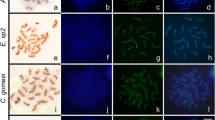Abstract
By means of silver staining procedures of light microscopy the characteristics of the nucleolus and the NORs have been investigated in meiocytes of different grasshopper species. Our results show that: (1) Two is the most common number of chromosomes per haploid genome carrying active NORs although this number may vary from one up to five; (2) NOR activity is preferentially located on medium and short chromosomes but the X and the megameric chromosome are involved in nucleolar organization in a high proportion of the species studied; (3) The NOR location is normally restricted to one end in acro-telocentrics and to the short arm, near the centromere region, in metacentrics; (4) A marked correlation is observed between the number of nucleoli present in the spermatogonial cells and in the first meiotic prophase of a given species; (5) In some cases, the nucleoli are associated to chromosomes during spermatogonial premetaphases.
Similar content being viewed by others
References
Bush, H. & Smetana, K., 1970. The nueleolus. Academic Press, New York, 1970.
Czaker, R., 1978. Silver staining in transeriptionally active NORs of mitotic and meiotic cells in Acheta domesticus (Orthoptera). Chromosoma 68: 187–193.
Daskal, Y., Smetana, K. & Bush, H., 1980. Evidence from studies on segregated nucleoli that nucleolar silver staining proteins C23 and B23 are in the fibrillar component. Expl Cell Res. 127: 285–291.
De laTorre, C. & Giménez-Martín, G., 1982. The nucleolar cycle. In: The nucleolus, Jordan, E. G. & Cullis, C. A. (eds), pp. 153–177. Cambridge University Press, Cambridge.
Flavell, R. B. & Martini, G., 1982. The genetic control of nucleolus formation with special reference to common breadwheat. In: The nucleolus, Jordan, E. G. & Cullis, C. A. (eds.), pp. 111. Cambridge University Press, Cambridge.
Garcia de la Vega, C., López-Fernández, C., Gosálvez, J. & Rufas, J. S., 1982. Cytogenetic studies on Chorthippus jucundus (Fisch.) Orthoptera. II. Heterochrematin variation and NOR localization. Cytobios 34: 7–14.
Giménez-Martin, G., De la Torre, C., López-Sáez, J. F. & Esponda, P., 1977. Plant nucleolus structure and physiology. Cytobiologie 14: 421–462.
Goodpasture, C. & Bloom, S. E., 1975. Visualization of nucleolar organizer regions in mammalian chromosomes using silver staining. Chromosoma 53: 37–50 (1975).
Hofgärtner, F. J., Schmid, M., Krone, W., Zenzes, M. T. & Engel, W., 1979. Pattern of activity of nucleolus organizer during spermatogenesis in mammals as analyzes by silver-staining. Chromosoma 71: 197–216.
Hewitt, G. M., 1979. Animal Cytogenetics. Vol. 3: Insecta I. Orthoptera. Borntraeger, Berlin-Stuttgart.
John, B. & Hewitt, G. M., 1966. Karyotype stability and DNA variability in the Acrididae. Chromosoma 20: 155–172.
Kierszenbaum, A. L. & Tres, L. L., 1974. Nucleolar and perichromosomal RNA synthesis during meiotic prophase in the mouse testis. J. Cell Biol. 60: 39–53.
King, M. & John, B., 1980. Regularities and restrictions governing C-band variation in acridoid grasshoppers. Chromosoma 76: 123–150.
Lima-de-Faria, A., 1983. Molecular evolution and organization of the chromosomes. Elsevier, Amsterdam.
Miller, O. J., 1981. Nucleolar organizers in mammalian cells. In: Chromosomes today. Vol. 7. Bennett, M. D., Bobrow, M. & Hewitt, G. M. (eds), George Allen & Unwin, London.
Miller, D. A., Dev, V. G., Tantravahi, R. & Miller, O. J., 1976a. Suppression of human nucleolus organizer activity in mouse human somatic hybrid cells. Expl Cell Res. 101: 235–243.
Miller, O. J., Miller, D. A., Rev, O. G. & Croce, C. M., 1976b. Expression of human and suppression of mouse nucleolus organizer activity in mouse-human somatic cell hybrids. Proc. natn. Acad. Sci. U.S.A. 73: 4532–4533.
Olert, J., 1979. Interphase studies with a simplified method of silver staining of nucleoli. Experientia 35: 283–285.
Ritossa, F. M., Atwood, K. & Spiegelmann, S., 1966. A molecular explanation of the bobbed mutants of Drosophila as partial deficiencies of ribosomal DNA. Genetics 54: 819–834.
Rufas, J. S. & Gosálvez, G., 1982. Development of silver stained structures during spermatogenesis of Schistocerca gregaria. (FORSK.) (Orthoptera acrididae). Caryologia 35: 261–267.
Santos, J. L., Arana, P. & Giráldez, R., 1983. Chromosome C-banding patterns in spanish Acridoidea. Genetica 61: 65–74.
Schmid, M., Löser, C., Schmidtke, J. & Engel, W., 1982. Evolutionary conservation of a common pattern of activity of nucleolus organizers during spermatogenesis in vertebrates. Chromosoma 86: 149–179.
Tres, L. L., 1974. Nucleolar RNA synthesis of meiotic prophase spermatocytes in human testis. Chromosoma 53: 121–144.
White, M. J. D., Dennis, E. S., Honeycutt, R. L., Contreras, N. & Peacok, W. J., 1982. Cytogenetics of the parthenogenetic grasshopper Warramaba virgo and its bisexual relatives. IX. The ribosomal RNA cistrons. Chromosoma 85: 181–199.
Author information
Authors and Affiliations
Rights and permissions
About this article
Cite this article
Rufas, J.S., Esponda, P. & Gosálvez, J. NOR and nucleolus in the spermatogenesis of acridoid grasshoppers. Genetica 66, 139–144 (1985). https://doi.org/10.1007/BF00139718
Received:
Accepted:
Issue Date:
DOI: https://doi.org/10.1007/BF00139718




